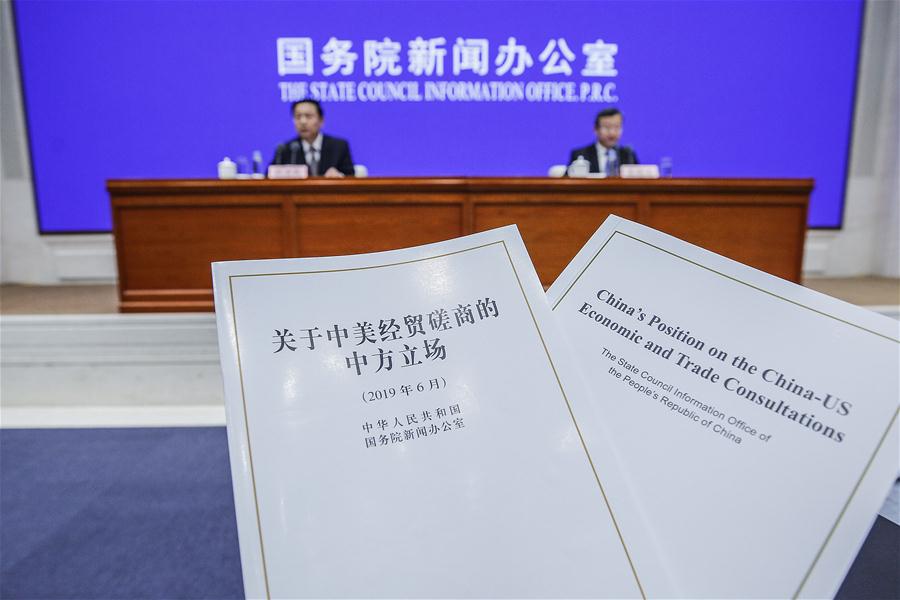Chinese white paper exposes flaws in Trump's 'America First' policy
- By Yang Fanxin
 0 Comment(s)
0 Comment(s) Print
Print E-mail China.org.cn, June 9, 2019
E-mail China.org.cn, June 9, 2019

The State Council Information Office (SCIO) on June 2 released a white paper offering a comprehensive and much-anticipated picture of the current Sino-American trade friction.
"China's Position on the China-U.S. Economic and Trade Consultations" represents the authentic voice of the Chinese on their concerns over the trade restrictions launched by the United States some 15 months ago.
The white paper contains approximately 8,300 words, summarizing the history of growing trade friction and the general situation of the bilateral trade talks, as well as explaining China's principles and position on the various issues that have emerged.
Why was it considered necessary to issue a white paper at this time? As the document points out, China always follows the principle of mutual respect, equality and mutual benefit to push forward consultations, and the situation has reached the stage where it considered it necessary to speak out on the whole process and stress that both sides should address identified issues, narrow differences and expand common interests based on good faith and credibility.
The three key words of "mutual respect, equality and mutual benefit" show Chinese government's strong mind of defending the interests of ordinary people on both sides of the divide.
Since the Trump administration imposed a ban on business with China's telecom leader Huawei, people have seen how the U.S. government uses various tools to destroy the interests of the Chinese business.
On May 16, the U.S. Commerce Department formally placed Huawei on its so-called "Entity List" – a move that bans the telecom company from buying parts and components from American firms without Washington's approval. This is a savage ban that, as the white paper states, has pushed Chinese government to take forceful measures to defend the interests of the nation and its people.
What's behind the current impasse? Surely, the Trump administration's "America First" policy should take the main blame, as it is being used to justify a series of unilateral and protectionist measures; it has regularly wielded the weapon of imposing tariffs to force other countries to accept its demands.
However, what does the "America First" policy really mean in global terms? It translates into the U.S. not pulling its troops out of Afghanistan, not withdrawing its forces from Syria. Meanwhile, it has led to the U.S. withdrawing from the Paris climate accord, the Iran nuclear deal, the U.N.'s top human rights and educational agencies, and the Trans-Pacific Partnership trade deal.
President Trump even boasted about his actions in opening trade talks with China and denuclearization talks with the Democratic People's Republic of Korea (DPRK) although no deals have emerged because of his repeated backtracking on the consultations.
The white paper clearly shows how the U.S., on three occasions, backtracked on its commitments in the China-U.S. economic and trade consultations. The first time was when the U.S. government falsely accused China of "IP theft" and "forced technology transfers," and subsequently announced an additional tariff of 25% on Chinese exports to America worth US$50 billion.
The second time was the Trump administration tore up the consensus that had been achieved on refraining from triggering an all-out trade war, imposing additional tariffs of 25% on Chinese exports worth US$50 billion, and raising the existing level of tariffs from 10% to 25% on US$200 billion of Chinese exports, on May 10.
The third incidence of backtracking occurred when the U.S. launched procedures to slap additional tariffs on remaining Chinese goods worth around US$300 billion, clearly showing its desire to put maximum pressure on China, forcing it into reaching a deal.
Maximum pressure is a significant brand of President Trump's diplomacy. He used it on the issues related to Russia, the DPRK and Iran through imposing economic sanctions, and is now doing the same during the trade consultations with China.
However, this approach of maximum pressure will not work as Trump fondly imagined. U.S. trade bullying is detrimental not only to the two countries directly involved, but the rest of the world.
Cooperation is the only correct choice for China and the U.S., and win-win is the only path to a better future, as the white paper stresses on behalf of the Chinese people.
The consultations should follow the principles of mutual respect, equality, mutual benefit, and respecting a country's sovereignty and dignity. This Chinese white paper is a definite call for sanity to avoid hurting both bilateral and multilateral interests where there are no winners only losers.
Yang Fanxin is an associate research fellow at the Chongyang Institute for Financial Studies, Renmin University of China.
Opinion articles reflect the views of their authors, not necessarily those of China.org.cn.
If you would like to contribute, please contact us at opinion@china.org.cn.






Go to Forum >>0 Comment(s)